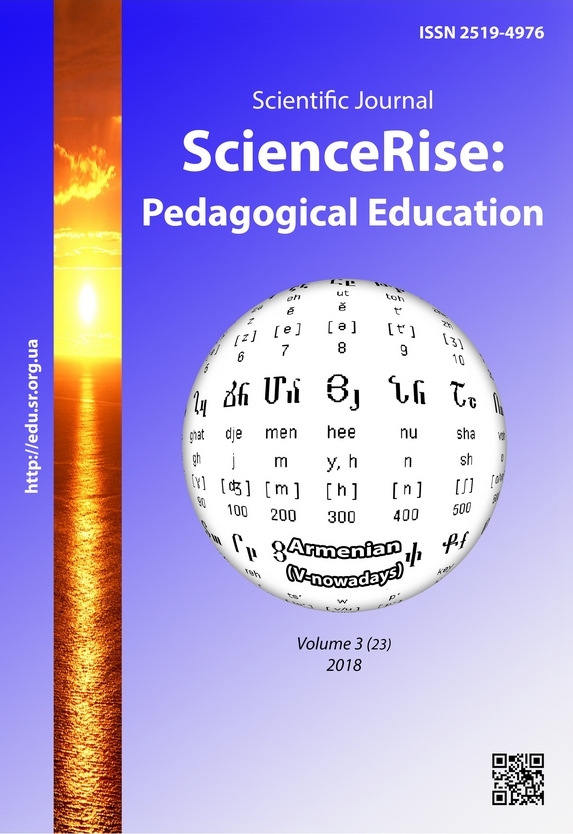Comparative analysis of student self-governance participation in governmental structure in Canada and Ukraine
DOI:
https://doi.org/10.15587/2519-4984.2018.126045Keywords:
student government, governmental structure, university, higher education, administration, academic senateAbstract
Based on the analysis of scientific sources and the results of the empirical research, in this article a comparative analysis of student self-governance participation in governmental structure in Canada and Ukraine has been done. It has been found out the peculiarities of university governmental structure in Canada and Ukraine. The positions and functions of the administration members have been characterized. It has been determined and compared the percentage of students` involvement in the main governing bodies of the universities in Ukraine and Canada.
The governing bodies of Ukrainian universities the author associates with the Academic Council of the University (as well as the Academic Councils of the faculties / institutes) and the labor collective conference. The percentage of students – members of the Academic Council in Ukrainian universities is no less than 10 %, while at Canadian University the figure is 16 %. In this article, the author compares the highest governing body of Canadian Universities - the Board of Directors (8 % of the delegates are students) with the highest collegiate body of public self-government in Ukrainian universities – labor collective conference (where no less than 15 % of delegates are student representatives)
References
- Zabolotna, O. (2016). Non-formal education in Ukraine in early 20th century: aspiring for better life or learning to live in crisis? History of Education & Children`s Literature, XI (1), 237–248.
- Demchenko, Yu. (2015). Osoblyvosti orhanizatsii studentskoho samovriaduvannia u VNZ. Osoblyvosti formuvannia tvorchoi osobystosti u vyshchii i zahalnoosvitnii shkolakh, 42 (95), 544–550.
- Vasylchenko, Ya., Yezhova, O. (2014). Normatyvno-pravovi zasady samovriaduvannia u vyshchykh navchalnykh zakladakh Ukrainy. Nauka i osvita, 8, 64–67.
- Kazlakova, H. (2011). Vyshcha osvita v Kanadi: deiaki vrazhennia pro universytety Ottavy i Toronto. Vyshcha osvita Ukrainy, 1, 114–116.
- Shpak, O. (2010). Osoblyvosti upravlinnia v suchasnii systemi vyshchoi osvity. Molod i rynok, 12 (77), 11–13.
- Rusnak, I. (2012). Studentske samovriaduvannia yak zasib formuvannia upravlinskykh umin maibutnikh fakhivtsiv. Pedahohichnyi dyskurs, 12, 275–277.
- Council of Ministers of Education. Available at: https://www.cmec.ca/ Last accessed: 26.02.2018
- Jones, G. A., Skolnik, M. L. (1995). Governing board at Canadian Universities: Characteristics, Role, Function, Accountability, and Representativeness. Toronto, 30. Available at: https://files.eric.ed.gov/fulltext/ED391413.pdfLast accessed: 26.02.2018
- Lider tekhnichnoi osvity Ukrainy. Available at: http://kpi.ua/kpi_about Last accessed: 26.02.2018
- Jones, G. A., Shanahan, T., Goyan, P. (2001). University governance in Canadian higher education. Tertiary Education and Management, 7 (2), 135–148. doi: 10.1080/13583883.2001.9967047
- Jones, G. A., Shanahan, T., Goyan, P. (2004). The academic senate and university governance in Canada. Canadian Journal of Higher Education, 34 (2), 35–68. Available at: http://journals.sfu.ca/cjhe/index.php/cjhe/article/view/183456/183409
- McGill University Organization Chart (Administration and Governance). Available at: https://www.mcgill.ca/orgchart/ Last accessed: 26.02.2018
- What Exactly Is A Provost? Available at: https://www.nmu.edu/academicaffairs/whatisaprovost Last accessed: 26.02.2018
- Struktura upravlinnia KPI. Available at: http://kpi.ua/structure Last accessed: 26.02.2018
- Statut Natsionalnoho tekhnichnoho universytetu Ukrainy «Kyivskyi politekhnichnyi instytut imeni Ihoria Sikorskoho» (Nova redaktsiia). Available at: http://kpi.ua/regulation Last accessed: 26.02.2018
Downloads
Published
How to Cite
Issue
Section
License
Copyright (c) 2018 Anna Pidhaietska

This work is licensed under a Creative Commons Attribution 4.0 International License.
Our journal abides by the Creative Commons CC BY copyright rights and permissions for open access journals.
Authors, who are published in this journal, agree to the following conditions:
1. The authors reserve the right to authorship of the work and pass the first publication right of this work to the journal under the terms of a Creative Commons CC BY, which allows others to freely distribute the published research with the obligatory reference to the authors of the original work and the first publication of the work in this journal.
2. The authors have the right to conclude separate supplement agreements that relate to non-exclusive work distribution in the form in which it has been published by the journal (for example, to upload the work to the online storage of the journal or publish it as part of a monograph), provided that the reference to the first publication of the work in this journal is included.








